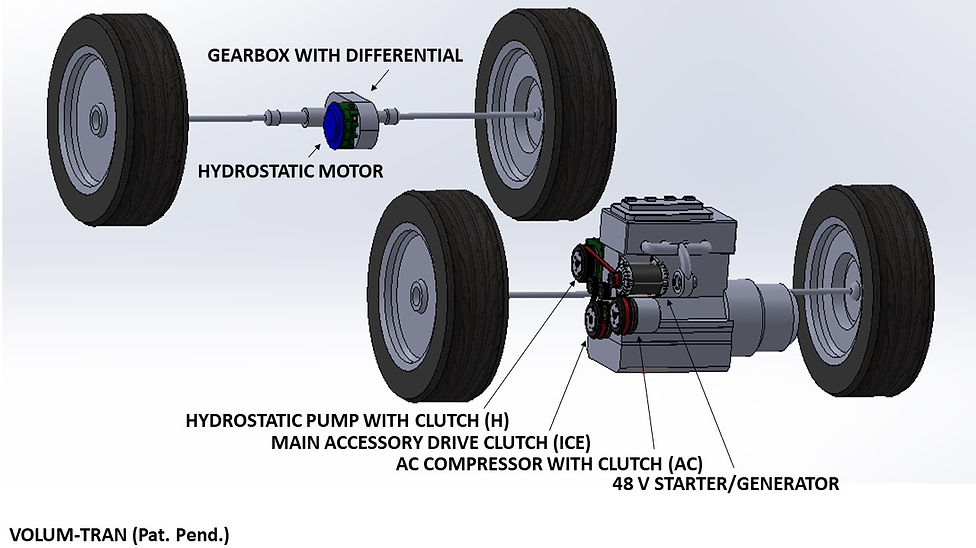A
VT - HM - Mild Hybrid
On VT - TECHNOLOGY page important aspects of this new hybridization approach is given: Here recapitulation will be given; starting from the most advanced concept and that is VT - Mild Hybrid with AWD4WD, ZEV and torque vectoring capabilities. Further below one can find concepts from which this; the most advanced one evolved. At the end one can find explanation of the motivation for this kind of mild hybrids.
Key component, shown below, is rear axle with two hydrostatic modulators, integrated into the driveline toward each wheel in te way that they 'cup' cams are connected and in addition that they can be blocked by central brake.

When central brake is applied all parts painted in red will be blocked and hydrostatic modulators will act as hydrostatic motors providing AWD4WD and/or ZEV capabilities in low speed range i.e. below 40 km/h.
Above 40 km/h central brake is released and advantage of hydrostatic modulator became apparent.
All mentioned can be achieved with standard hydrostatic motor but, as modern integral transmissions has to provide torque vectoring too, this new design, hydrostatic modulator, is needed. If torque vectoring is realized with standard low cost i.e. fix displacement motors non-acceptable losses, associated with high noise level will be generated. This problem can be solved by hydrostatic rotational modulator(s). As they are used only to control speed difference, between wheels at which they are attached, level of oil flow and/or noise generation, is significantly reduced. Namely, during straight drive, when there is no speed difference between wheels, there is no flow and/or noise generation. During cornering, at high speeds, around 100 km and more, speed difference between wheels is small i.e. well below 40 km/h so that associated losses and/or noise generation should be acceptable, as much lover than in low speed regime when hydrostatic rotational modulator is used as the motor.
When central brake is released and pressure isn't applied all parts, green and red will turn with same speed or more precisely with the speed set by the wheels connected to the hydrostatic rotational modulator as shown on image below.

But, during maneuvering, when pressure is applied with different sign so that external wheel is pushed to go faster and internal wheel is pushed to go slower function of torque vectoring will be realized, still as commutation will be related to the speed difference among wheels and not they absolute speed, even when pressure is applied during torque vectoring, commutation losses and associated noise will be low.
Everything else is same as it was with concept proposed before invention of hydrostatic modulator presented below.

Pressure is provided by the hydrostatic pump mounted on the accessory belt side. A side of the introduction of the mentioned hydrostatic pump, with clutch (H), this concept is inventive due to the fact that ICE can be disconnected to by the clutch (ICE) . Having 48 V starter / generator of 10 kW deferent modes of functioning can be provided. One additional interesting aspect is possibility to run AC COMPRESOR by the 48 V starter / generator when ICE is off.
This variant is somehow more complicated than basic variant that doesn't need to change anything in ICE compartment but due to the fact that 48 V starter/generator is used, instead electric starter of 1.5 kW much higher performance can be achieved, and as 48 V starter/generator is already integrated into the modern ICE no need for additional electric motor isn't needed as it is case with electromechanical systems i.e. cost / performance ratio is improved
VT4WD - Basic
VT4WD Basic is version of the system that is designed around existing integrated hydrostatic transmission, one that is shown/used in technology demonstrator already seen...

VT4WD - Basic >> Platform Integration
One of the strong points, of the Basic VT4WD is simplicity of the integration into the vehicle platform. Namely, going with electric motor of 1500 W, actually one aligned with power of the alternator; there is no modification in engine compartment. As electric motor can be connected to the 12 V electric grid through bipolar connector, and as system is autoregulated no additional control and/or power electronic design isn't needed.
As power input is obtained by electric motor, not prop-shaft, it is much easier to find integration volume that has to be assigned for iVT4WD integration:

Transversal Integration

Work on mild hybrids, in scope of the VT R&D , is inspired by the facts that hydrostatic transmissions, at this level of the stat of the art, can provide good efficiency in low speed (high torque) range where internal combustion engine are working out of 'sweet spot' i.e. they are generating lot of the harmful emission, especially in slow advancement during traffic jams.

This harmful emission can be reduced using ZEV, provided with electrohydraulic mild-hybrid solution, so that at low speeds, where ICE is working out of the efficiency sweet spot ICE can be turn off and advancement will be realized using energy from the batteries.
Under the vision of the VT R&D electrohydraulic active suspension can be used to related height control. Using height control i.e. reducing clearance between vehicle and road air drag can be reduced so that electrohydraulic can indirectly help to reduce harmful emission at high speeds to (still this is project that is planed for at least end of 2021).
In addition VT project will provide 4WD option that will get new value with IV phase where height control can be used to increase clearance between vehicle and terrain improving off-road handling.
Aside of the 4WD option VT project will provide starting boost as it transfers power toward rear wheels with CVT performance allowing starting with max torque at font at rear wheels.
Special advantage came with hydrostatic torque modulation allowing torque vectoring and/or drifting i.e. fun to drive aspect of the driving.
---and all that with interesting performance/price ratio ...